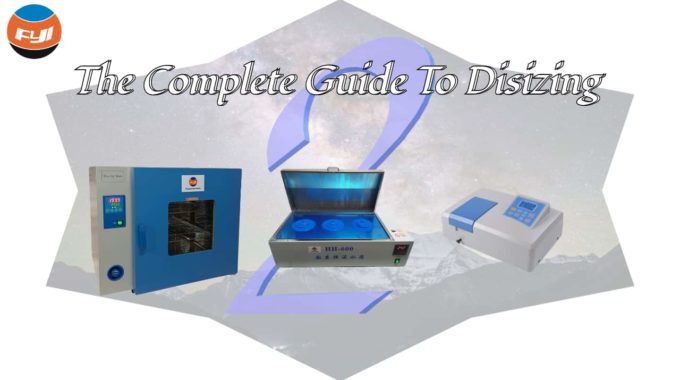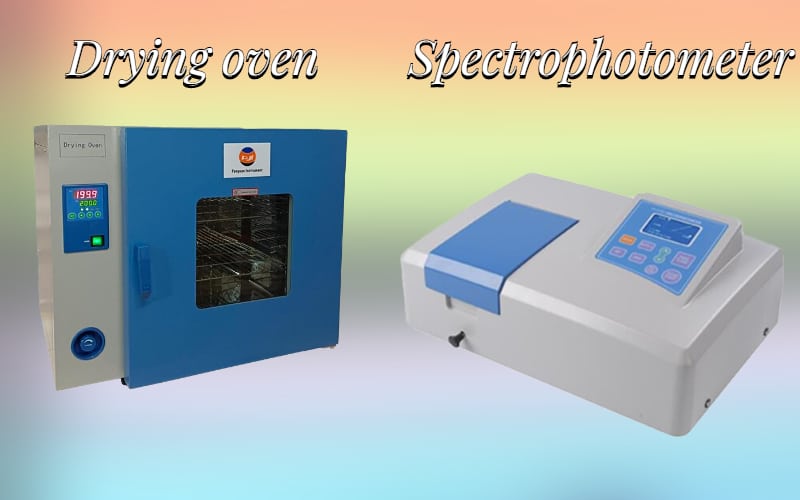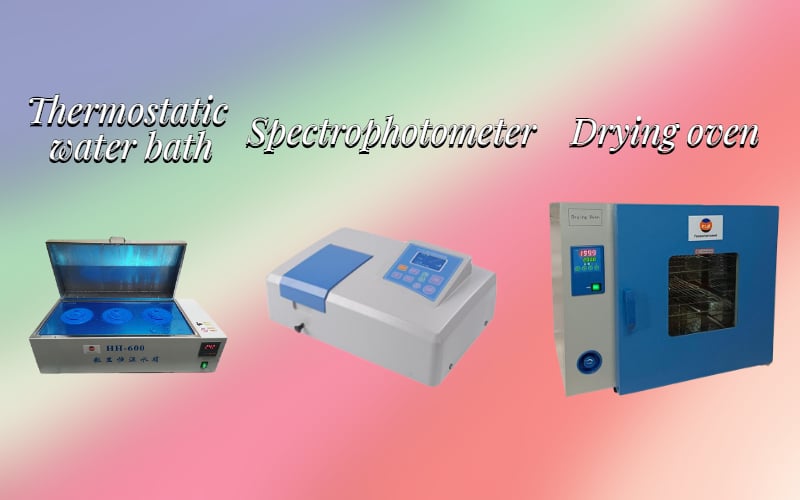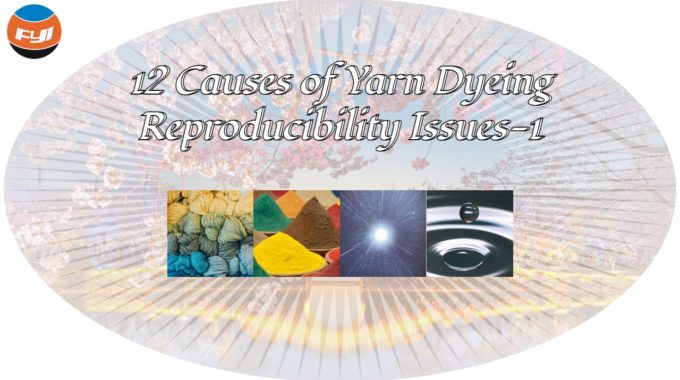
The Complete Guide to Desizing-2
Desizing is an important process before dyeing-finishing, the desizing results directly affect the inner and appearance quality of fabric dyeing and printing. The previous articles mentioned the identification of sizes, types of desizing agents, and qualitative methods for measuring desizing rates. In this article, let’s take a look at the process of quantitative determination of desizing rate.
Contents
Quantitative method for starch desizing rate
Determination principle
Perchloric acid can dissolve starch, starch on fabric can be impregnated with perchloric acid solution and dissolve in the solution. Starch forms a blue complex with iodine in a certain pH range. The maximum absorption wavelength of the aqueous solution of this complex is about 620nm, and it conforms to beer’s law when the starch concentration is in a certain range. So the starch desizing rate can be calculated by determining the starch content before and after desizing by colorimetric method.
Main instruments and reagent solutions for starch desizing rate
(1)Instrument
Spectrophotometer; Drying oven.

(2)Reagent solution
Perchloric acid, 42% solution; Acetic acid, prepared into c=2mol/L solution; Sodium hydroxide, prepared into c=6mol/L solution; Potassium iodide, in a 10% solution; Potassium iodate, prepared into c=0.05mol/L solution; Phenolphthalein indicator, 0.5% 90% ethanol solution.
(3)Draw a standard curve
Accurately measure 50mg starch (accurate to 0.1mg), dissolve it in 42% perchloric acid solution of about 20mL, drop 1-2 drops of phenolphthalein indicator solution, add sodium hydroxide solution of C =6mol/L until the solution turns pale red, and then add drops of acetic acid of C =2mol/L until the pale red disappears.Transfer to a 500mL volumetric flask and dilute to scale with distilled water. The solution contained starch 0.1mg/mL. Absorb 3mL, 6mL, 10mL, 15mL, 20mL, 25mL and 30mL of the solution to the numbered 50mL volumetric flask, add 25mL of c=2mol/L acetic acid solution, 0.5ml of 10% potassium iodate solution, and then add 2mL of C =0.05mol/L potassium iodate solution. Diluted with distilled water to scale (at this time, the mass concentration of starch is 6mg/L, 12mg/L, 20mg/L, 30mg/L, 40mg/L, 50mg/L, 60mg/L), with blank solution as the reference solution, the absorbance was measured [temperature is (25±1)℃.A standard curve was drawn with absorbance as ordinate and starch mass concentration as abscissa.
(4)Test of sample
The cloth sample to be tested is cut into small pieces and placed in the oven at 100-105 ℃ for drying. A certain amount of dry cloth sample is accurately measured (the sampling amount is determined according to the pulp content of the cloth sample, the general grey cloth is 0.5-1g, and the desized fabric is 2-5g), placed in a 250mL beaker, and about 30ml of 42% perchloric acid solution is added to make the sample completely immersed in the solution. Leave at room temperature for 30 minutes, stirring constantly.Then add 100mL distilled water and 1-2 drops of phenolphthalein indicator, add sodium hydroxide solution with C(NaOH)=6mol/L until the solution appears light red, and then add C(HAc)=2mol/L acetic acid until the light red just disappears. Filtrate is collected or transferred to a 250mL volumetric flask and diluted to scale with distilled water. Put 5mL of the above solution into a 50mL volumetric flask, add 25mL of c(HAc)=2mol/L acetic acid solution, 0.5ml of 10% KI solution and 2mL of C =0.05mol/L KIO3 solution, dilute to scale with distilled water. After stable color development, colorimetry was carried out immediately and absorbance was measured. Compare with the standard curve to find the starch mass concentration of the measured solution.
(5)Calculate desizing rate
Starch content=C·d·V/W×l0-6×100%
C——Corresponding starch mass concentration on the standard curve,mg/L;
d——Dilution ratio of extraction solution,In the above methods, is 50/5=10;
v——Volume of starch extract (250mL in the above method),mL;
W——Weight of test cloth,g.
Desizing rate = starch content on the blank cloth – starch content on the desized cloth/starch content on the blank cloth ×100%
(6)Notes
①The chromogenic reaction of this test should be completed after adding reagent and sitting for 5min, and then colorimetry is carried out. However, as the starch-iodine complex is stable under light for about 15min, over 15min the solution may become cloudy, so the shelving time should not be too long, and it is best to avoid light.
②Starch will be hydrolyzed in acidic medium, so when using perchloric acid to dissolve starch, the temperature should not be too high and the time should not be too long (the temperature in the test was room temperature, the time was 30min). If 42% of perchloric acid is made by diluting 72% of perchloric acid, concentrated acid diluting is an exothermic reaction, so it should be cooled to room temperature before use.
Quantitative method of PVA desizing rate
Test principle
PVA aqueous solution in the presence of boric acid can immediately form a blue complex with iodine. When PVA is in a certain concentration range, the relationship between the absorbance of the complex and the concentration of PVA conforms to Beer’s law. Therefore, if the PVA on the fabric is dissolved, the content of PVA can be determined by colorimetric method. The desizing rate can be calculated by measuring the PVA content of grey cloth and desizing fabric respectively.However, the maximum absorption wavelength of the blue complex formed by PVA-HBO3-I2 varies from 580nm to 700nm with the ratio of boric acid and iodine-potassium iodide. When the amount of boric acid was relatively high, the maximum absorption wavelength shifted to the side with the longer wavelength. On the contrary, it moves to the side with shorter wavelength. In the test, the concentration and dosage of boric acid solution and iodine-potassium iodide solution should be well controlled, so that the maximum absorption wavelength of complex aqueous solution is stable.
Main instruments and reagent solutions for PVA desizing rate
(1)Instrument
Spectrophotometer; Thermostatic water bath; Oven, etc.

(2)Reagent solution
Boric acid bath solution: weigh 2.5g boric acid in 90mL distilled water, heat until dissolved, dilute to 100mL.
Iodide-potassium iodide solution: accurately weigh 1.3g iodine and 1.8g potassium iodide in a 100mL volumetric flask with distilled water for constant volume; After dissolving, dilute 25mL to scale in a 100mL brown volumetric flask.
(3)Draw a standard curve
Weigh 50mg(accurate to 0.1mg) polyvinyl alcohol (PVA), place it in a 500mL flask, add 150mL distilled water, boil reflux for 1h. Filtration, filtrate cooling and washing liquid together into 500mL volumetric bottle, diluted to scale with distilled water, shake well. A certain amount of the above solution (1mL, 3mL, 5mL, 7mL, 10mL, 13mL, 17mL) was transferred to a 50mL volumetric flask.In each volumetric flask, 15mL of boric acid solution and 1.5mL of iodide-potassium iodide solution were added after dilution with a small amount of distilled water. Finally, diluted to the scale with distilled water (at this time, the mass concentration of PVA is 2mg/L, 6mg/L, 10mg/L, 14mg/L, 20mg/L, 26mg/L, 34mg/L), placed in a thermostatic water bath at (25±1)℃, after the temperature is balanced, The blank solution was used as the reference solution for colorimetry, and the absorbance of each solution at 690nm was determined.The standard curve was drawn with the mass concentration of PVA (mg/L) as the abscissa and the absorbance as the ordinate.
(4)Determination of sample
A small piece of cloth sample to be tested was cut into pieces and placed in a 105℃ oven for drying. A certain amount of dry sample was accurately weighed (the sampling amount should be determined according to the fabric pulp content, so that the PVA content is within the range of 25-75 tons), placed in a 500mL flask, and 50mL distilled water was added, and heated and boiled for reflux.Filter and wash the sample with a little distilled water for several times (iodine-boric acid test drops on the sample, if there is no blue color, it means that THE PVA on the sample has been washed). After cooling, move the filtrate (including the washing solution) into a 250mL volumetric flask, dilute it with distilled water to the scale, and shake well. Transfer 5mL of the solution to a 50mL volumetric flask and dilute to scale with distilled water.The above solution was placed in a thermostatic water bath, and the absorbance (690nm) of the reference solution was measured immediately after the temperature was balanced [(25±1)℃], and then the corresponding mass concentration of PVA was found on the standard curve.
(5)Calculate desizing rate
PVA content=C·d·v / W×10-6×100%
C——Corresponding PVA mass concentration on the standard curve,mg / L
d——Dilution ratio of extraction solution,in the above methods, is50/ 5=10
V——Volume of PVA extract (250mL in the above method),mL
W——Weight of test cloth,g
Desizing rate = PVA content on bad cloth – PVA content on desized cloth sample/PVA content on bad cloth x100%
(6)Notes
①To prevent condensation, the solution must be diluted with an appropriate amount of distilled water and shaken continuously while boric acid and iodide-potassium iodide solutions are added.
②The order of adding reagent solution should not be reversed. If iodine – potassium iodide solution is added first, the result will be low.
③The test results show that the mass concentration of PVA in the range of 0–34mg/L is in line with Beer’s law, and the mass of the cloth sample should be weighed according to the change of slurry content on the test cloth, so that the concentration of the solution to be tested is in this range.
④The temperature of the colorimetric solution has an effect on the absorbance, and the test should be carried out at (25 ±1)℃. When the temperature increases or decreases by 1℃, the absorption value decreases or increases by 2%.
⑤In this experiment, λMax is 690nm. Due to the change of the dosage of boric acid and iodide – potassium iodide, the weighing must be accurate.
The PVA specification used to draw the standard curve shall be similar to the PVA specification on the cloth sample to be tested.
Conclusion
| Qualitative method | Quantitative method | |
| Starch | Reagent: iodine test solution TEGEWA standard color card | Reagents: Perchloric acid solution, Acetic acid solution, Sodium hydroxide solution, KI solution, KIO3 solution |
| PVA | Reagent: iodine – boric acid test solution | Reagents: Boric acid bath solution, iodide-potassium iodide solution |
| Application | Factory | Laboratory |
| Instrument | — | Uv spectrophotometer, oven, constant temperature water bath |
| Advantage | Simple and quick determination of desizing effect | Accurate desizing rate can be obtained, which is convenient to study and optimize desizing process |
| Disadvantage | The desizing rate cannot be obtained accurately | Time consuming and tedious process |
Comments are closed.



Wow, I am really inspired with your writing talent well with the layout to your weblog.
The steps for measuring the desizing rate are very detailed. Even if I am a layman, I can see that the author has consulted a lot of information in writing this article.
This blog was very helpful for my graduation thesis, very happy to find such a great textile related website
Your writing consistently exceeds my expectations.